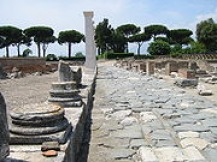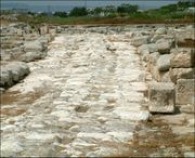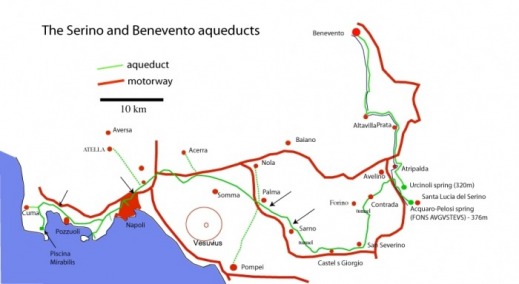Roads of Beneventum
The Via Appia was perhaps the most important roman road, built in the third century B.C. In 312 B.C., Appius Claudius Caecus was appointed Censor in Rome as a populous leader, meaning for the people[1]. The same year, the Appian way began and finished construction. This road linked Rome to Capia in the south, and later on extended to Beneventum and Taranto. Roman roads, which were developed as a means of transport for military armies, supplies and diplomats began to extend into increasingly remote territories as the Roman Republic expanded[2].
In 109 A.D. the Emperor Trajan financed construction of the Via Traiana, which merged into the Via Appia at Beneventum[3]. Upon completion of this new roadway, The Via Appia lost all previous importance as a military connection to southern cities such as Venusia and Tarentum. The Arch of Trajan marked the entrance of the new roadway into the city.
Aqueducts
Roman aqueducts served as a means of water transportation mainly agriculture, military outposts, and public and private water fountains. Engineers developed the aqueducts to run downhill, and whenever possible, underground[4]. Remains of any aqueduct above ground are few and far between because of this. Benevento was served by its own aqueduct that is sometimes associated with the Serino aqueduct. The Beneventum aqueduct, which is not named, starts from a lower source than the Serino and crosses the Sabato river twice[5].
The Serino aqueduct was one of the largest aqueducts in the Roman Empire, but not much is known about it because there are virtually no remains of the visible arches[6].
1. Giulio Giannelli. 1967. The World of Ancient Rome. New York: Macdonald Company Ltd.
2. Giannello. 245.
3. Giannello 246. 4. Wilke Schram. 2007. Serino (Italy). http://www.romanaqueducts.info/aquasite/serino/index.html. (accessed December 4, 2008). 5.Schram. 2 6.Schram. 2 i. Appian remains. (image). Appian Way. < http://en.wikipedia.org/?title=Appian_way > (accessed Dec 2008). ii. Appian Traiana remains. (image). Appian Way. < http://en.wikipedia.org/?title=Appian_way > (accessed Dec 2008). iii. Trajans Marker. (image). The world of Ancient Rome. New York: Macdonald & Co. Ltd, 1967, 246. iv.Road Construction. (image). The world of Ancient Rome. New York: Macdonald & Co. Ltd, 1967, 248. v. Serino and Beneventum Aqueducts. (image). Serino (Italy). < http://www.romanaqueducts.info/aquasite/serino/index.html > (accessed Dec 2008).





